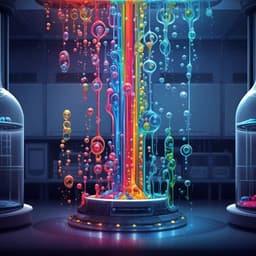
Engineering and Technology
A direct coupled electrochemical system for capture and conversion of CO2 from oceanwater
I. A. Digdaya, I. Sullivan, et al.
A groundbreaking electrochemical system has been developed to capture CO2 directly from oceanwater, paving the way for net-negative emissions and sustainable synthetic fuels. This innovative approach, conducted by Ibadillah A. Digdaya, Ian Sullivan, Meng Lin, Lihao Han, Wen-Hui Cheng, Harry A. Atwater, and Chengxiang Xiang, showcases high efficiencies and a unique pathway for carbon capture.
~3 min • Beginner • English
Introduction
The study addresses the challenge of achieving negative carbon emissions by capturing and converting CO2 from dilute sources, specifically oceanwater, which serves as the largest carbon sink and contains an effective CO2 concentration far higher than the atmosphere. Prior efforts have focused on point sources due to higher CO2 concentrations, but long-term negative emissions will require direct capture from air or the oceans. Ocean capture presents logistical and energy challenges (e.g., intake, pretreatment, outfall) but offers advantages such as large-scale capacity and potential offshore deployment. The research question is whether a fully electrochemical, directly coupled system can efficiently acidify oceanwater to release dissolved inorganic carbon as CO2 and convert it electrochemically to value-added products with low energy consumption. The purpose is to design and demonstrate a BPM electrodialysis (BPMED) system that avoids energy-penalizing water-splitting at electrodes by employing reversible redox couples, minimizing voltage losses, and to directly couple the captured CO2 to a vapor-fed CO2R cell. The importance lies in establishing a low-energy pathway for ocean-based CO2 capture and utilization that could be viable at scale and synergize with renewable energy and desalination infrastructure.
Literature Review
Two main electrodialysis designs have been reported for CO2 extraction from seawater: configurations constrained by water-splitting at electrodes (HER/OER), which introduce significant voltage and energy penalties. Prior BPMED implementations either tied CO2 capture to H2 generation in single-stack setups with untunable ratios or required multi-stack configurations to mitigate voltage penalties from water splitting. Indirect ocean capture and other ocean-based CO2 removal concepts also exist, but costs for stand-alone land-based systems are dominated by intake and pretreatment. Co-location with desalination can reduce energy and cost, though scale may be limited by plant capacities. Vapor-fed CO2 electroreduction has been shown to overcome CO2 solubility limits in aqueous electrolytes, enabling higher current densities and selectivity, especially on Cu and Ag catalysts, and is a promising route for coupling with capture units.
Methodology
Device design: A BPMED cell comprising two oceanwater compartments separated by a bipolar membrane (BPM), flanked by two redox-couple electrode compartments each separated from oceanwater by a cation-exchange membrane (CEM), and two electrodes. The BPM dissociates water at the junction to supply H+ to acidify one oceanwater stream and OH− to basify the other. The electrode compartments contained reversible one-electron potassium ferro/ferricyanide redox couple solutions (K3/K4[Fe(CN)6]) recirculated to minimize concentration overpotentials. Electrode reactions: cathode [Fe(CN)6]4− + e− → [Fe(CN)6]5−; anode [Fe(CN)6]5− → [Fe(CN)6]4− + e−. CEMs provide charge balance by selectively transporting cations.
Flow scheme: Incoming oceanwater first passed through three series membrane contactors (3M Liqui-Cel MM-0.5×1) under vacuum to strip dissolved gases (O2, N2). The acidified stream was then directed through another three series contactors under vacuum to extract dissolved CO2; moisture was condensed in a dry-ice cold trap. The acidified effluent was subsequently sent to the base compartment for pH restoration prior to disposal.
Operating conditions and measurements: Optimized operation at 3.3 mA cm−2 and oceanwater flow rate of 37 ml min−1 yielded acidified stream pH ≈4.7. Cell voltages were measured for various electrode solutions and flow conditions; replacing conventional 0.5 M Na2SO4 with K3/K4[Fe(CN)6] minimized electrode overpotentials and total cell voltage. A multiphysics model simulated BPM voltage-current characteristics, ion transport fractions (H+, OH−, Na+, Cl−), and pH vs current at given flow rates, showing water dissociation dominates above ~0.4 mA cm−2 and >93% of current carried by H+/OH− at ≥3.3 mA cm−2.
CO2 quantification: The vacuum-extracted gas was initially mixed with N2 in a mixing chamber and analyzed by gas chromatography. CO2 capture efficiency was defined as the ratio of measured CO2 gas output rate to the DIC input rate; membrane contactor efficiency as measured CO2 gas rate over the dissolved CO2 rate expected at the acidified pH and flow.
Vapor-fed CO2R: The BPMED CO2 stream was fed directly to tandem vapor-fed cells: a first oxygen reduction (ORR) pre-cell to remove residual O2, followed by the CO2R cell. Working electrodes: Cu sputtered onto PTFE GDL (Sterlitech) and Ag nanoparticles drop-cast on carbon GDL (Ion Power Sigracet 29 BC). Three-electrode configuration with Pt mesh counter and Ag/AgCl reference (1 M KCl in anolyte). Bulk electrolysis: For Cu, −1.14 V vs RHE for 2 h, average CO2 flow ≈2.2 sccm, anolyte flow 5 ml min−1; current densities 53–77 mA cm−2. For Ag, −0.6 V vs RHE, current densities 7.6–11.7 mA cm−2. Gas products were analyzed by GC (Molsieve 5A and Haysep 5D columns; isothermal 90 °C; TCD and FID with methanizer). Faradaic efficiencies (FEs) computed from product fractions, current, and molar flow; liquid products quantified by HPLC (Aminex HPX 87-H, 1 mM H2SO4 eluent) with FE from moles detected and total charge. Single-pass conversion was computed from CO2 inflow and product formation.
Additional analyses: Energy consumption for oceanwater handling and vacuum stripping estimated for stand-alone vs co-located with desalination. Techno-economic analysis (discounted cash flow) estimated levelized cost of capture, with equipment cost breakdown highlighting membrane contactors. Modeling guided optimization of current density and flow to minimize energy consumption and maximize CO2 output. Effects of Mg2+/Ca2+ on basified stream pH were assessed; oceanwater softening discussed as mitigation.
Key Findings
- Replacing electrode water splitting with reversible ferro/ferricyanide redox couples in a BPMED cell substantially reduced cell voltage and energy consumption for CO2 capture from oceanwater.
- At 3.3 mA cm−2 and 37 ml min−1 flow, acidified stream pH ≈4.7, measured cell voltage ~1 V, and electrochemical energy consumption stabilized at 0.98 kWh kg−1 CO2 (155.4 kJ mol−1).
- CO2 capture performance: After 1 h stabilization, total gas output ≈2.1 sccm with CO2 concentration ~93% (O2 ~1.5%, N2 ~5.5%). DIC rate ≈2.8 sccm; ideal CO2 output ≈2.6 sccm. Measured CO2 capture efficiency reached 71%; membrane contactor efficiency 76%. Maximum capture efficiency observed was 77% at oceanwater pH 3.7 (~99% of DIC converted to dissolved CO2). Three serial membrane contactors were required to achieve >70% capture; single contactor yielded lower efficiency, and vacuum contactor removal typically maximizes at ~80%.
- Ion transport and BPM behavior: Above ~0.4 mA cm−2, current predominantly carried by H+/OH− generated at the BPM interface; >93% at ≥3.3 mA cm−2. Co-ion leakage (Na+, Cl−) dominated only at very low current densities.
- pH restoration: Basified stream theoretical pH ≈10.46 (matching acid compartment proton generation), but measured pH ~8.5 due to precipitation with Mg2+ and Ca2+; softening restores agreement with calculations.
- Vapor-fed CO2R coupling: Using Cu catalyst at −1.14 V vs RHE, total FE to CO2R products ~73% (HER ~20%), relatively stable over 2 h, single-pass conversion ~6.7%, current densities 53–77 mA cm−2, producing CO, C2H4, ethanol, and propanol. Using Ag catalyst at −0.6 V vs RHE, FE to CO >90% for much of the run (up to 95% reported), HER as low as 5%, single-pass conversion ~9.7%, current densities 7.6–11.7 mA cm−2; selectivity declined over time due to GDL flooding. Presence of O2 in the feed led to parasitic ORR consuming >80% of electrons in Ag-based cell, underscoring need for O2 removal.
- System optimization: At 37 ml min−1, optimal operating current density window ~1.5–3.5 mA cm−2 minimized energy consumption while maximizing CO2 output as pH approached ~4. Increased flow requires higher current to maintain low pH; increased current raises polarization losses.
- Energy and cost: Estimated total energy (excluding BPMED) for stand-alone land-based capture 4.6 kWh kg−1 CO2; co-location with desalination reduces this to 0.075 kWh kg−1 CO2. Projected BPMED electrochemical energy at industrial current densities ~1.22 kWh kg−1 CO2, giving a co-located total ~1.30 kWh kg−1 CO2, favorable compared to DAC (1.54–2.45 kWh kg−1 CO2). Levelized costs estimated at $0.50–$0.54 kg−1 CO2 (co-located) and $1.87–$2.05 kg−1 CO2 (stand-alone); membrane contactors comprise ~60% of equipment cost. BPMED cost-effectiveness improves at >60 mA cm−2; operationally matching CO2 flux suggests CO2R current density roughly 4× BPMED current density for a 6e− process with high utilization and selectivity.
Discussion
The BPMED design directly addresses the main inefficiency in prior electrodialysis-based ocean capture systems by eliminating electrode water splitting, thereby reducing thermodynamic and kinetic voltage penalties and cutting energy consumption for CO2 liberation from oceanwater. Maintaining the acidified stream near pH ~4 converts most dissolved inorganic carbon to dissolved CO2, which is effectively stripped via vacuum membrane contactors. The resulting CO2 stream can be directly utilized in a vapor-fed CO2R setup, demonstrating an integrated capture-to-conversion pathway. The need for O2-free CO2 feeds is critical to avoid parasitic ORR losses, as shown by the ORR pre-cell and separate tests. The observed basified stream pH shortfall (relative to theoretical) due to Mg2+/Ca2+ precipitation highlights an operational constraint for alkalinity restoration; pretreatment via softening can mitigate this and is necessary if returning water to the ocean without ecological harm. From a systems perspective, co-location with desalination substantially reduces non-electrochemical energy penalties and overall energy requirements compare favorably to DAC. The TEA indicates that equipment cost is dominated by membrane contactors, suggesting that process innovations which directly convert dissolved CO2 or enhance vacuum contactor performance could lower costs substantially. There is a trade-off between operating at higher current densities to reduce membrane area cost and the increased energy losses due to BPM polarization; optimization will depend on scale, membrane cost, and electricity pricing. Overall, the findings validate the feasibility of a fully electrochemical, directly coupled ocean capture and utilization pathway with competitive energy intensity and promising economics when integrated with existing infrastructure.
Conclusion
This work demonstrates a directly coupled electrochemical system that captures CO2 from oceanwater using a BPMED cell with reversible redox electrodes and converts the captured CO2 in a vapor-fed CO2R cell. By eliminating electrode water splitting and optimizing ion transport through the BPM, the system achieves low electrochemical energy consumption (0.98 kWh kg−1 CO2) and high capture efficiency (up to 77% under more acidic conditions, 71% under optimized conditions), delivering a concentrated CO2 stream suitable for downstream electroreduction. Coupling to vapor-fed CO2R yields high Faradaic efficiencies, including up to 95% to CO on Ag and multi-carbon products on Cu. Energy and techno-economic analyses suggest that co-location with desalination plants can provide total energy requirements competitive with or better than DAC and levelized capture costs as low as $0.50–$0.54 kg−1 CO2. Future research should focus on: improving BPM water dissociation kinetics and reducing series resistance to lower operating voltages at higher current densities; developing direct electrochemical conversion of dissolved CO2 to reduce or eliminate membrane contactors; mitigating Mg2+/Ca2+ precipitation via pretreatment and assessing environmental impacts of effluent alkalinity; enhancing GDL durability to prevent flooding; and scaling and process integration to optimize the trade-offs between energy consumption and membrane cost.
Limitations
- Laboratory-scale constraints set flow (37 ml min−1) and current density (3.3 mA cm−2); performance and economics at industrial-scale higher current densities will involve increased BPM polarization losses.
- Capture efficiency was limited by vacuum membrane contactor performance (~80% maximum removal), series configuration complexity, and potential air leakage; three contactors were needed for >70% capture.
- Basified stream pH did not reach theoretical values due to precipitation with Mg2+/Ca2+; requires feed softening or alternative alkalinity management, with uncertain environmental impacts if returning high-pH brine to the ocean.
- Vapor-fed CO2R performance degraded over time due to GDL flooding; O2 contamination leads to significant ORR parasitic losses, necessitating additional pre-treatment.
- The TEA relies on assumptions for scale-up, equipment costs (notably membrane contactors), and integration with desalination; real-world costs may vary. The system currently requires vacuum stripping and gas handling complexity, which add to balance-of-plant energy and capital requirements.
Related Publications
Explore these studies to deepen your understanding of the subject.







